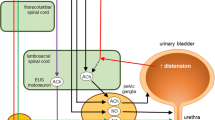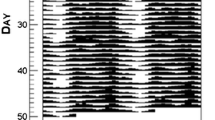Abstract
Aim
To implant deep brain stimulation (DBS) electrodes in the porcine pontine micturition centre (PMC) in order to establish a large animal model of PMC-DBS.
Method
Brainstems from four Göttingen minipigs were sectioned coronally into 40-μm-thick histological sections and stained with Nissl, autometallographic myelin stain, tyrosin hydroxylase and corticotrophin-releasing factor immunohistochemistry in order to identify the porcine PMC. DBS electrodes were then stereotaxically implanted on the right side into the PMC in four Göttingen minipigs, and the bladder response to electrical stimulation was evaluated by subsequent cystometry performed immediately after the operation and several weeks later.
Findings
A paired CRF-dense area homologous to the PMC in other species was encountered in the rostral pontine tegmentum medial to the locus coeruleus and ventral to the floor of the fourth ventricle. Electrical stimulation of the CRF-dense area resulted in an increased detrusor pressure followed by visible voiding in some instances. The pigs were allowed to survive between 14 and 55 days, and electrical stimulation resulting in an increased detrusor pressure was performed on more than one occasion without affecting consciousness or general thriving. None of the pigs developed postoperative infections or died prematurely.
Conclusions
DBS electrodes can be implanted for several weeks in the indentified CRF-dense area resulting in a useful large animal model for basic research on micturition and the future clinical use of this treatment modality in neurogenic suprapontine voiding disorders.








Similar content being viewed by others
References
Abelson JL, Curtis GC, Sagher O, Albucher RC, Harrigan M, Taylor SF, Martis B, Giordani B (2005) Deep brain stimulation for refractory obsessive-compulsive disorder. Biol Psychiatry 57:510–516
Andersen JT (1985) Disturbances of bladder and urethral function in Parkinson’s disease. Int Urol Nephrol 17:35–41
Barrington FJF (1925) The effect of lesion of the hind- and mid-brain on micturition in the cat. Q J Exp Physiol 15:81–102
Benarroch EE, Schmeichel AM (2001) Depletion of corticotrophin-releasing factor neurons in the pontine micturition area in multiple system atrophy. Ann Neurol 50:640–645
Bjarkam CR, Cancian G, Larsen M, Rosendahl F, Ettrup KS, Zeidler D, Blankholm AD, Ostergaard L, Sunde N, Sorensen JC (2004) A MRI-compatible stereotaxic localizer box enables high-precision stereotaxic procedures in pigs. J Neurosci Methods 139:293–298
Bjarkam CR, Jorgensen RL, Jensen KN, Sunde NA, Sorensen JC (2008) Deep brain stimulation electrode anchoring using BioGlue((R)), a protective electrode covering, and a titanium microplate. J Neurosci Methods 168:151–155
Bjarkam CR, Sorensen JC (2004) Therapeutic strategies for neurodegenerative disorders: emerging clues from Parkinson’s disease. Biol Psychiatry 56:213–216
Bjarkam CR, Sorensen JC, Sunde NA, Geneser FA, Ostergaard K (2001) New strategies for the treatment of Parkinson’s disease hold considerable promise for the future management of neurodegenerative disorders. Biogerontology 2:193–207
Blok BF, Holstege G (1997) Ultrastructural evidence for a direct pathway from the pontine micturition center to the parasympathetic preganglionic motoneurons of the bladder of the cat. Neurosci Lett 222:195–198
Blok BF, Holstege G (2000) The pontine micturition center in rat receives direct lumbosacral input. An ultrastructural study. Neurosci Lett 282:29–32
Blok BF, Willemsen AT, Holstege G (1997) A PET study on brain control of micturition in humans. Brain 120(Pt 1):111–121
Dalmose AL, Bjarkam CR, Djurhuus JC (2005) Stereotactic electrical stimulation of the pontine micturition centre in the pig. BJU Int 95:886–889
Dalmose AL, Hvistendahl JJ, Olsen LH, Eskild-Jensen A, Djurhuus JC, Swindle MM (2000) Surgically induced urologic models in swine. J Invest Surg 13:133–145
de Groat WC (1997) A neurologic basis for the overactive bladder. Urology 50:36–52
Epstein LB, Goldberg RP (2005) The overactive bladder and quality of life. Int J Fertil Womens Med 50:30–36
Geirsson G, Fall M, Lindstrom S (1993) Subtypes of overactive bladder in old age. Age Ageing 22:125–131
Giannantoni A, Scivoletto G, Di Stasi SM, Grasso MG, Vespasiani G, Castellano V (1998) Urological dysfunctions and upper urinary tract involvement in multiple sclerosis patients. Neurourol Urodyn 17:89–98
Holstege G, Mouton LJ (2003) Central nervous system control of micturition. Int Rev Neurobiol 56:123–145
Holstege GF, Griffiths DF, de Wall HF, Dalm E (1986) Anatomical and physiological observations on supraspinal control of bladder and urethral sphincter muscles in the cat. J Comp Neurol 250(4):449–461
Hung SW, Hamani C, Lozano AM, Poon YY, Piboolnurak P, Miyasaki JM, Lang AE, Dostrovsky JO, Hutchison WD, Moro E (2007) Long-term outcome of bilateral pallidal deep brain stimulation for primary cervical dystonia. Neurology 68:457–459
Kenney C, Simpson R, Hunter C, Ondo W, Almaguer M, Davidson A, Jankovic J (2007) Short-term and long-term safety of deep brain stimulation in the treatment of movement disorders. J Neurosurg 106:621–625
Kumar R, Lozano AM, Sime E, Lang AE (2003) Long-term follow-up of thalamic deep brain stimulation for essential and parkinsonian tremor. Neurology 61:1601–1604
Kuru M, Yamamoto H (1964) Fiber connections of the pontine detrusor nucleus (Barrington). J Comp Neurol 123:161–185
Larsen M, Bjarkam CR, Ostergaard K, West MJ, Sorensen JC (2004) The anatomy of the porcine subthalamic nucleus evaluated with immunohistochemistry and design-based stereology. Anat Embryol (Berl) 208:239–247
Larsen M, Bjarkam CR, Stoltenberg M, Sorensen JC, Danscher G (2003) An autometallographic technique for myelin staining in formaldehyde-fixed tissue. Histol Histopathol 18:1125–1130
Loewy AD, Saper CB, Baker RP (1979) Descending projections from the pontine micturition center. Brain Res 172(3):533–538
Mayberg HS, Lozano AM, Voon V, McNeely HE, Seminowicz D, Hamani C, Schwalb JM, Kennedy SH (2005) Deep brain stimulation for treatment-resistant depression. Neuron 45:651–660
Noto H, Roppolo JR, Steers WD, de Groat WC (1989) Excitatory and inhibitory influences on bladder activity elicited by electrical stimulation in the pontine micturition center in the rat. Brain Res 492:99–115
Pahwa R, Lyons KE, Wilkinson SB, Simpson RK Jr, Ondo WG, Tarsy D, Norregaard T, Hubble JP, Smith DA, Hauser RA, Jankovic J (2006) Long-term evaluation of deep brain stimulation of the thalamus. J Neurosurg 104:506–512
Pettersen R, Stien R, Wyller TB (2007) Post-stroke urinary incontinence with impaired awareness of the need to void: clinical and urodynamic features. BJU Int 99:1073–1077
Podnar S, Trsinar B, Vodusek DB (2006) Bladder dysfunction in patients with cauda equina lesions. Neurourol Urodyn 25:23–31
Sugaya K, Matsuyama K, Takakusaki K, Mori S (1987) Electrical and chemical stimulations of the pontine micturition center. Neurosci Lett 80:197–201
Tanaka Y, Koyama Y, Kayama Y, Kawauchi A, Ukimura O, Miki T (2003) Firing of micturition center neurons in the rat mesopontine tegmentum during urinary bladder contraction. Brain Res 965:146–154
Vesper J, Steinhoff B, Rona S, Wille C, Bilic S, Nikkhah G, Ostertag C (2007) Chronic High-Frequency Deep Brain Stimulation of the STN/SNr for Progressive Myoclonic Epilepsy. Epilepsia 48(10):1984–1989
Vincent SR, Satoh K (1984) Corticotropin-releasing factor (CRF) immunoreactivity in the dorsolateral pontine tegmentum: further studies on the micturition reflex system. Brain Res 308:387–391
Acknowledgements
This study was made financially possible thanks to the Danish Medical Research Council, the Karen Elise Jensen Foundation and the Aarhus University Research Foundation. We acknowledge with gratitude the technical assistance of Dorete Jensen, Lise Moberg Fitting, Albert Meier and the staff at Paaskehoejgaard.
Author information
Authors and Affiliations
Corresponding author
Additional information
Comment
This is a well-structured, interesting and well-written paper. It has a well-structured scientific design. Based on their previous published paper, the authors have proved that pontine micturation centre can be positively influenced by means of deep brain stimulation.
Since it is known that many neurological patients with neurodegenerative diseases suffer from urinary dysfunction and many attempts have been made with only partial success to influence those disorders, it is an important approach. It seems to be worthwhile to investigate this in the future in order to minimise the still-existing technical difficulties.
Jan Vesper
University of Dusseldorf, Germany
Grant sponsors: The Danish Medical Research Foundation, The Karen Elise Jensen Foundation, The Aarhus University Research Foundation.
Rights and permissions
About this article
Cite this article
Jensen, K.N., Deding, D., Sørensen, J.C. et al. Long-term implantation of deep brain stimulation electrodes in the pontine micturition centre of the Göttingen minipig. Acta Neurochir 151, 785–794 (2009). https://doi.org/10.1007/s00701-009-0334-1
Received:
Accepted:
Published:
Issue Date:
DOI: https://doi.org/10.1007/s00701-009-0334-1




